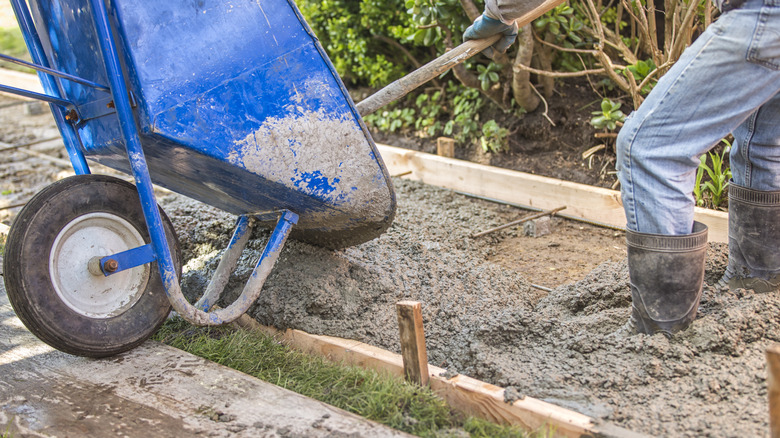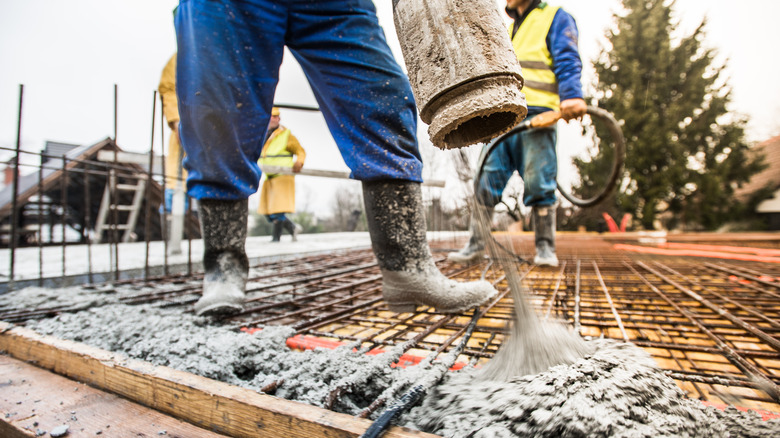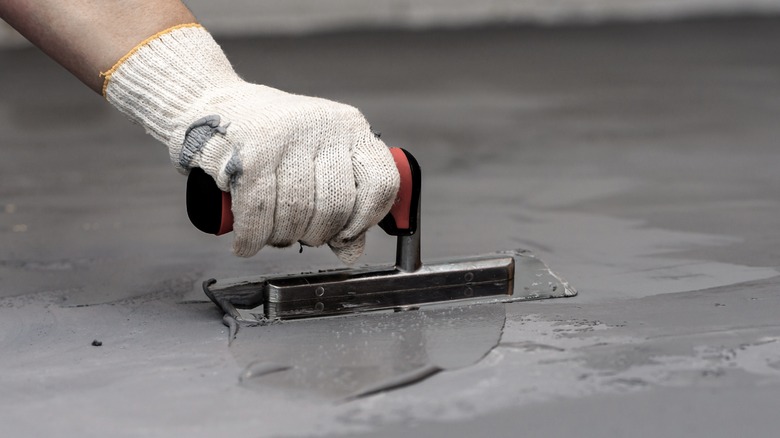The DIY Concrete Mistake That Could Leave You In Serious Pain
Taking on DIY projects to maximize storage space or otherwise improve your home is a great way to save money while creating something practical and beautiful. As your skills improve, you may be tempted to take on tougher projects, like adding a DIY concrete patio to your backyard. Before you begin working with concrete solo for the first time, though, you need to understand the dangers of this material.
One potential issue with concrete that's receiving plenty of attention online is the possibility of burning your skin. A TikTok video from user @diycoach.co shows that skin burns from concrete can happen to almost anyone, including professional contractors. Other videos show the painful consequences of getting these injuries.
Concrete can cause burns when it reacts with water because it's a highly alkaline substance with a pH of 12 (on a scale of 0 to 14, with 7 being neutral). Alkali burns are especially dangerous because of liquefactive necrosis, in which alkalis continue penetrating the skin after contact and create deep-tissue injuries, according to an article published in the Annals of Burns and Fire Disasters. These effects can be mitigated, however, if you rinse the area immediately with cool water, per the National Capital Poison Center (NCPC). No matter what kind of concrete-based product you're using, including mortar and grout, there are ways to use it safely.
How to avoid skin burns from concrete
The dangers of wet concrete occur when it makes contact and reacts with your skin. The best preventative measure, then, is to cover up when working around this material. This should include waterproof boots, full-length coveralls, long-sleeved shirts, and waterproof gloves made specifically for use around chemicals. Don't forget to wear either a face shield or safety goggles, just in case the wet concrete splashes. Concrete can also cause damage to other tissues, such as the mouth, eyes, and throat (via NCPC), so use maximum protection.
@diycoach.co Replying to @surveyingadventures 99% of C-8 contractors have this problem… Don’t let the concrete burns scare you, here’s a trick to fight it! CLICK THE + to concrete better. You may like this vid: @diycoach.co Ever wonder how to make your own concrete?: @diycoach.co #fyp #foryou #concrete #contractor
Worth noting is that concrete burns can take a few hours or longer to manifest. You may not even realize that you've been exposed right away, as this wet material can penetrate some clothing. For example, if you're wearing short boots when working around concrete, some of the material could fall inside and eventually penetrate the skin around your feet and ankles. It can also penetrate some gloves. Since you may not realize contact has occurred for a few hours, this may lead to further harm from the burns.
You also should wear protective clothing when dumping bags of concrete into a bucket or wheelbarrow for mixing. If the dust makes contact with wet skin, it can cause a similar reaction, depending on the amount of moisture it encounters.
How to treat a potential concrete burn
The best way to treat a concrete burn is to immediately wash the exposed area for at least 15 minutes with cool or room-temperature water (via NCPC). You should also remove any protective clothing or safety gear that was exposed. Put on different gear if you need to continue working.
If you do suffer one of these burns, the best solution is to rinse the area with diluted vinegar, according to the Occupational Safety and Health Administration. Because vinegar is a weak acid, its pH level sits between 2 and 3, allowing it to balance out the alkali that is wet concrete. A TikTok video from user @eddiesoto827 demonstrates that this rinsing process can still be painful, but it's necessary for balancing the pH level of the exposed skin. If you don't have vinegar on hand, you can use another acidic liquid, such as citrus juice.
WebMD recommends calling for emergency medical care if the burn is more than 3 inches across. You should also inform any nurses or doctors assisting you that the burn is from concrete to ensure proper treatment. MCR Safety warns against covering the burn with lotion or petroleum jelly, as these can seal the alkali underneath, leading to more damage.


